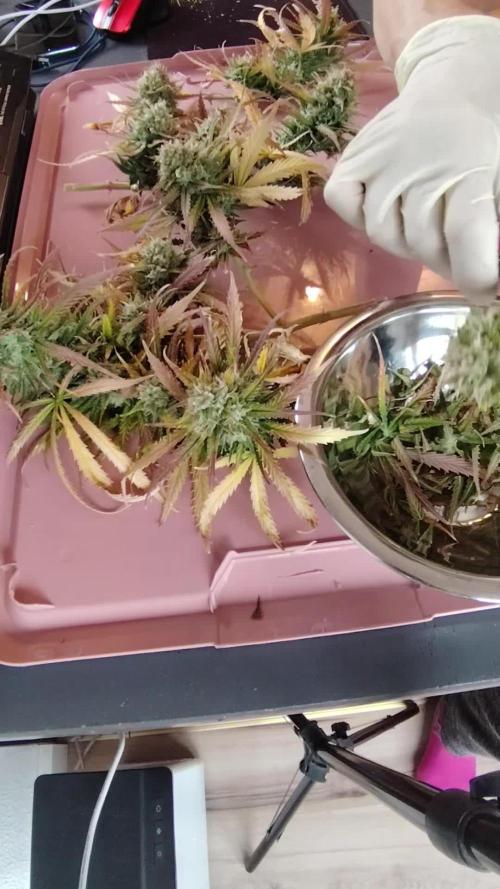The Grow Awards 2026 🏆 































Likes
Comments
Share


@FatnastyzBudz
Follow
3-17
Photo bombs today 😂😂
Gave 4ml green sensation, 3ml cal/mag and 1 ml slf-100.
Run off ppm 1300 ph 7.0
Hope can get the ph down a bit.
3-21
1.5 grams game time, 3ml green sensation, 3ml cal/mag, 1ml Slf-100 ph 6.0 ppm 350
Runoff 1432 ph 6.9
Yo, dropped 1 💪🤘
See ya next week
Likes
23
Share


@StantonGrowsUk
Follow
Switched it up to 600w on the digital ballast. Plants really love the extra heat. 2 plants hermied unfortunately so they were "Outta There"
Which left me with 4 healthy stretch ladies. Still no loud smell yet but it's got something there.
We got some likkle buds too 😍
Girls are doing well they took well to the foliar spray I was applying twice a week. They are loving the extra space to stretch it seems.
Feeding with water this week to regulate ppm within substrate.
Proud parent 👏
See you guys next week
Be good
Stanton..
Likes
30
Share


@DrewbieDoobieNoobie
Follow
It still looks like there humming along gonna give one more week of veg after transplanting them so the roots can settle in. I don't want to stress them with to much after repotting them as the roots were air pruning though the 3 gal pots. My freaking camera stopped taking pictures at day 4 of week 4 not sure why, then today the power went out in my neighborhood it happened around the dark cycle so I hope with that and the transplanting it would not stress them to much. Another VEG feeding this week with extra (N) I hope the pale ones benefit from that. I diluted the food per the advice of you all to 500 ppm @ 6.0 ph will see how it goes this week I will post more at the end of the week as always.
Thanks Drewbie
Likes
7
Share


@GrowSmith
Follow
Week eight started on the 30th
Contemplating whether to finish on week eight, as I’ve got a good mixture of brown trichomes with milky.
Would like to finish it with a lower percentage of brown
Likes
4
Share


@SherbGrows
Follow
Ganja Farmer Seeds
Mandarine Auto
Day 48
Light viparspectra XS2000 dialed in at 75% intensity
watering every other day to every two days
I am very happy thus far with the mandarine auto by ganja farmer. She has taken to LST very well and the buds are forming nicely. I am hoping this will be a good yielder
See you all next week! Happy Growing!
Likes
18
Share


@TheGreenLeopard
Follow
It’s a nice grow so far in terms of expectations reality on the seed breeders. Great stuff again. I had a real germination nightmare this time around though - lots of strains failing at seedling so the numbers and strains became more 😂. So the tents are mixed up again to auto on one side and photoperiod on the other. In this tent as well as Afghan and a red gorilla - there is sweet zensation , banana krumble and red hot cookies and a peyote skittlez. Water in using ro solely through the grow. There has been one issue. I tried a “pro” substrate from biocanna this time and I have those little fleas. Really annoying and my aphids are late so kind of annoying - takes the pleasure off a bit. Any good organic solutions let me know please on comments
Likes
22
Share


@Damonkey
Follow
Last 2-3 weeks of the grow period now, expecting the COP to finish up first and I’m guessing the PSS is going to push it to 10 weeks, at least I hope so, would be awesome to have a fairly nice yield from that one. It looks and smells so good just need a bit more swelling inna da buds. All looking great. However got a slight nute burn to all plants from one of the last feeds. Only very slight and it was picked up quickly. The following feed consisted of Tripple F and molasses soup, holding back all other nutes until the following feed. Problem seems to be sorted.
The grow becomes a little more of a challenge day by day, the weather here is worsening meaning colder and more humid day by day, my cramped circumstances don’t help the situation either. The hum coming from my room now is also a little to loud and when everything’s running at quiet times can be Heard, when it really shouldn’t be, although I don’t have problems with that at the moment who knows who might hear it at the wrong time🙄 oh spring hurry along please.
Likes
29
Share


@nonick123
Follow
Día 27 (20/05) Riego con 250 ml de Té de Compost
Auto Northern Dragon Fuel está creciendo exponencialmente!
Día 28 (21/05) Vuelven a tener sed! Las riego con 250 ml sólo H20 pH 6.2
Auto Northern Dragon Fuel se ha recuperado muy bien de la deficiencia de Mg
Día 29 (22/05) Riego con 750 ml H2O+ Regulator 0,15 ml/l + CaMg-Boost 0,25 ml/l + Startbooster 0,25 ml/l + TopBooster 0,2 ml/l- pH 6.2
Día 30 (23/05) Lemon Cherry Cookies Auto está sedienta de nuevo!
500 ml de sólo H2O con el pH 6.3
Día 31 (24/05) Lemon Cherry Cookies Auto está sedienta de nuevo!
Riego con 750 ml H2O + Regulator 0,15 ml/l + TopBooster 0,2 ml/l- pH 6.2
Día 32 (25/05) Las plantas no paran de crecer! 😍
Día 33 (26/05) Riego con 750 ml H2O + Regulator 0,15 ml/l + CaMg-Boost 0,25 ml/l + TopBooster 0,2 ml/l- pH 6.2
Lemon Cherry Cookies Auto tiene un olor increíble 😍😍😍
💦Nutrients by Aptus Holland - www.aptus-holland.com
🌱Substrate PRO-MIX HP BACILLUS + MYCORRHIZAE - www.pthorticulture.com/en/products/pro-mix-hp-biostimulant-plus-mycorrhizae
Likes
6
Share


@ZombieKushAddicted
Follow
to view this lamp or any other marshydro product go to: https://instagram.com/marshydro_aliexpress?igshid=YmMyMTA2M2Y=
Likes
39
Share


@Roberts
Follow
Bubble OG Gum auto is growing great. She is shifting more and more into flowering. She should start stretching a lot in next few weeks. 🤞🏻 she goes big. Everything is looking really good. She is eating a lot and drinking a lot of solution. I will likely do a solution change right as she gets to bulking. Unless she is just thriving, then I will hold off. Don't fix what is not broken. Thanks again Spider Farmer, Athena, and Ganja Farmer. 🤜🏻🤛🏻🌱🌱🌱
Thank you grow diaries community for the 👇likes👇, follows, comments, and subscriptions on my YouTube channel👇. ❄️🌱🍻
Happy Growing 🌱🌱🌱
https://youtube.com/channel/UCAhN7yRzWLpcaRHhMIQ7X4g
Likes
39
Share


@All_our_small_plants
Follow
-Tag 70 Pablitos letzte Stunde Nachdem wir die Trichome kontrolliert haben und gesehen haben dass sie reif sind, haben wir sie geerntet. Nass Gewicht waren es 155g. Nun hängt sie im Zelt zum trocknen 😍
Likes
2
Share


@CK-OrgGrow
Follow
Blüte Woche 8
Die Pflanzen entwickeln sich mega In dieser Woche habe ich denn EC wieder von 3,0 auf 2,5 heruntergesetzt.
Bei der Pflanze hinten Rechts gibt es keine weiteren Verschlechterungen oder Verbesserungen zu erkennen, aber sie entwickelt sich auch weiter, nur langsamer und anders :-).
Trichome (THC) entwickelt sich sehr heftig.
Likes
15
Share


@Uwish
Follow
Hello guys,
Here I am again to present you a new run, still with the best leds of the market nevertheless as I changed my growing space from 120x120 to 150x150. So I had to update the material inside...
I will run with 3 EVO 5-150 lamps of 320W or 960W with Bluetooth dimmers.
For the Hydro system, it will be the V-SYSTEM from Alienhydroponics.
In fertilizers I am always with Advanced Nutrients.
I work with osmosis water.
Currently, 4 clones took on 4.
Once the roots are ready, I will transfer the cuttings from the propagator to the V-SYSTEM.
------------------------
since the 16/08, when I transplanted the plants in the RDWC system, I noticed some points that I will mention below and correct next time.
1. The cuttings are too small, allow enough time so that I can completely fill my pots with clay balls.
2. Cut out the bottom of the pots from the cuttings.
3. 3/4 of the cuttings are touching the water, so one is late. Next time when transplanting, add more water, up to the basket in order to immerse all the plants and not to create a difference between each one, consequence now I have 3 that are ready to explode and one that will struggle behind, problem corrected today by increasing the volume of water.
4. The b-52 is a real pain in the ass in RDWC, you have to clean the 2 filters almost every day, with this new soup I'm testing without and I think I'll continue like this just with the base sensi grow A and B, as I use Root rot X, I won't use voodoo juice since all the bacteria would be killed.
5. Use of Voodoo Juice is useless if using Root Rot X which will kill the bacteria.
I don't know why but when I transplanted in the RDWC, I put my set up in growth mode, except that the plants were not ready for it, moreover, I made a FIM on each. So I lost some days, these last days I went back to a ppdf of 150, now that my roots touch the water, I declare growth 0 on 22/08, I will do between 21 and 28 days of growth. And as my roots are doing well and touching the water I'll go to a PPFD of 300
++
Likes
18
Share


@WeirdBeard
Follow
I'm glad that I have one more of these seeds to plant!! Also I still have one of their Blueberry domains and white widow !!! Loving these genetics!!!
Likes
103
Share


@PEAKYPLANTERS
Follow
good evening everyone, lovers of peaky queen gardens!
the scorg network technique is bringing its results and they show!
impressive instead is to see how the strains on the right are totally different structurally from those on the left!
mmmm ... I already smell good ...
Likes
36
Share


@MadeInGermany
Follow
Info:
Unfortunately, I had to find out that my account is used for fake pages in social media.
I am only active here on growdiaries.
I am not on facebook instagram twitter etc All accounts except this one are fake.
Flowering day 50
since time change
to 12/12 hrs.
Hey everyone ☺️.
Another nice week goes by.
The buds keep getting thicker and smell better ;-).
This week the water was poured twice with 1.2 l each time.
One of them with GHSC enhancer.
Otherwise everything was cleaned and checked.
lots of fun and stay healthy 🙏🏻
You can buy this Strain at
https://www.barneysfarm.com/blue-cheese-34
Type:
Blue Cheese
☝️🏼
Genetics:
Blueberry
X
Original Cheese
👍
Vega lamp:
2 x Todogrow Led
Quantum Board 100 W
💡
Bloom Lamp :
2 x Todogrow Led
Cxb 3590 COB 3500 K 205W
💡💡☝️🏼
Soil :
Bio Bizz Coco
☝️🏼
Fertilizer:
Green House Powder Feeding
☝️🏼🌱
Water:
Osmosis water mixed with normal water (24 hours stale that the chlorine evaporates) to 0.2 EC. Add Cal / Mag to 0.4 Ec Ph with Organic Ph - to 5.5 - 5.8


























